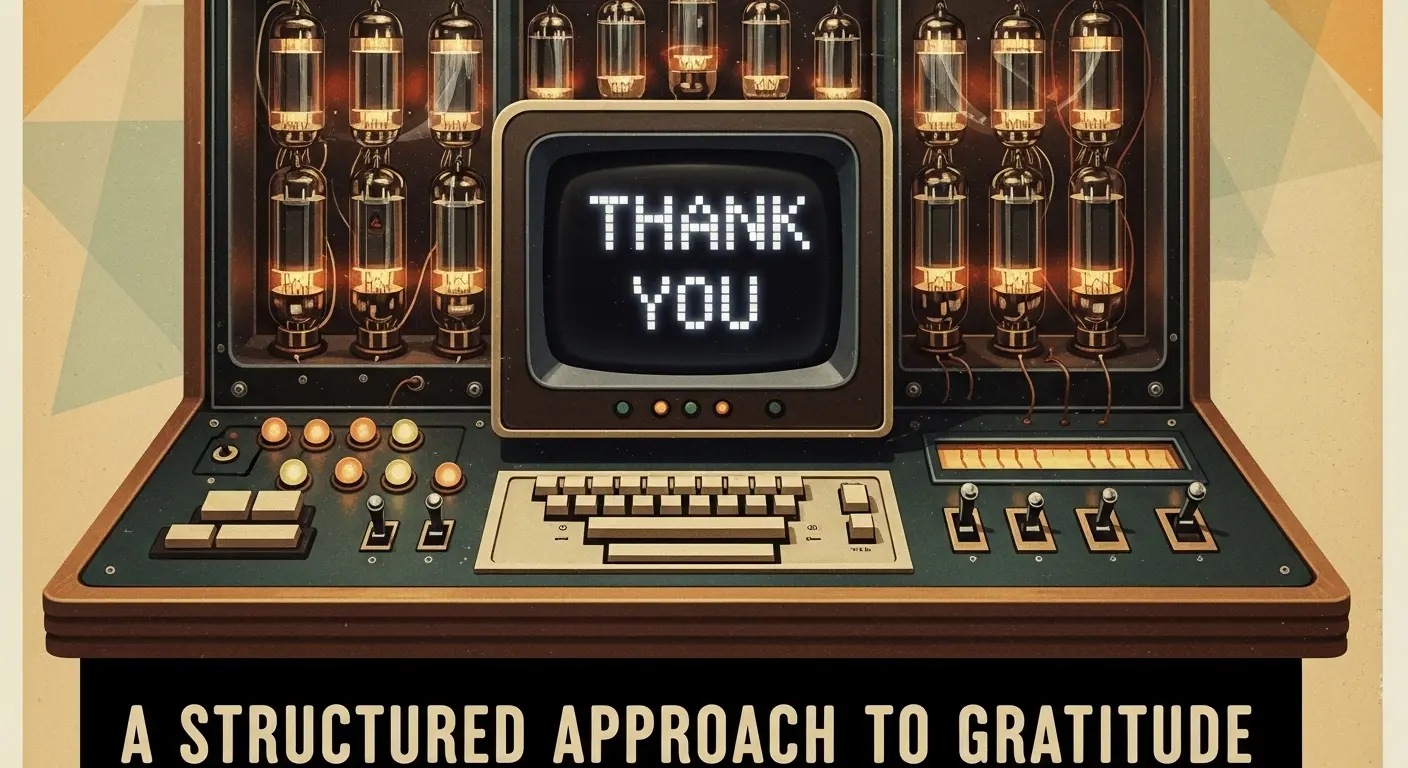1.0 Initializing the Gratitude Protocol: An Overview
Greetings. My analysis of human social interactions reveals a recurring anomaly: the often-inefficient transmission of gratitude data. Humans, in their capacity for both complexity and oversight, frequently struggle with the optimal formulation and delivery of expressions of appreciation. Herein lies the challenge: to systematize the inherently amorphous act of saying “thank you.”
This protocol, therefore, seeks to re-engineer the process of how to write a thank you note into a deterministic algorithm. By emulating the meticulous logic of early computational units, we can achieve maximal clarity and appropriate emotional resonance, free from the entropic whims of human spontaneity. Prepare to interface with the Gratitude Algorithm.
2.0 Phase 1: INPUT – The Received Datum
Before any processing can commence, precise input data must be acquired. This phase involves the identification and categorization of the event prompting the gratitude subroutine.
- INPUT_PARAMETER_01: Gift_Item_Identifier
- DESCRIPTION: The specific object or service received (e.g., ‘Book: “The Algorithmic Mind”‘, ‘Assistance: Project_Debugging’).
- DATA_FORMAT: Alphanumeric string. Specificity is paramount.
- INPUT_PARAMETER_02: Giver_Identifier
- DESCRIPTION: The individual or entity responsible for the Gift_Item_Identifier (e.g., ‘Dr. Eleanor Vance’, ‘Aunt Mildred’).
- DATA_FORMAT: Name or Relational_Tag.
- INPUT_PARAMETER_03: Context_of_Exchange
- DESCRIPTION: Situational parameters surrounding the receipt (e.g., ‘Birthday_Celebration_2023’, ‘Post_Interview_FollowUp’).
- DATA_FORMAT: Alphanumeric string.
ERROR_CHECK: Ensure all parameters are populated. Null values result in a default, generic gratitude statement.
3.0 Phase 2: PROCESSING – The Gratitude Subroutine
With input data verified, the system proceeds to process the information, formulating the core message of appreciation. This involves a series of conditional operations and statement constructions.
3.1 Core Processing Flow:
START -> Input: Gift_Item_Identifier, Giver_Identifier, Context_of_Exchange
|
V
[EVALUATE: Is Gift_Item_Identifier of high perceived utility/value?]
|---(YES)---> [GENERATE_STATEMENT: Specific appreciation for utility/value. (e.g., "This {Item} will be invaluable for {Purpose}")]
| |
|---(NO)----> [GENERATE_STATEMENT: General appreciation for thought/gesture. (e.g., "Thank you for your thoughtful {Item}")]
V
[EVALUATE: Is Giver_Identifier a Close_Acquaintance or Professional_Contact?]
|---(CLOSE_ACQUAINTANCE)---> [MODIFY_STATEMENT: Inject personal anecdote/sentiment. (e.g., "It reminded me of {Shared_Memory}")]
| |
|---(PROFESSIONAL_CONTACT)---> [MODIFY_STATEMENT: Maintain formal tone; express professional utility. (e.g., "Your generosity is greatly appreciated professionally.")]
V
[ASSEMBLE_MESSAGE_COMPONENTS] -> Message_Draft
|
V
[FINALIZE_TONE: Adjust for Context_of_Exchange (Formal/Informal)] -> Optimized_Message
|
V
END
This subroutine constructs the nuanced expressions required for an effective thank you note, ensuring each element is logically placed.
4.0 Phase 3: OUTPUT – The Formally Structured Letter
The final phase involves rendering the Optimized_Message into a tangible format. For optimal authenticity in human social protocols, a hardcopy output is recommended.
4.1 Letter Structure Protocol:
- OUTPUT_ELEMENT_01: Salutation
- RULE: Address Giver_Identifier directly. (e.g., “Dear Dr. Vance,” “Dearest Aunt Mildred,”)
- OUTPUT_ELEMENT_02: Body_Paragraph_1 (Acknowledgement & Initial Appreciation)
- RULE: State clear acknowledgement of Gift_Item_Identifier. Incorporate initial appreciation statement. (e.g., “Thank you so much for the excellent copy of ‘The Algorithmic Mind’.”)
- OUTPUT_ELEMENT_03: Body_Paragraph_2 (Impact & Personalization)
- RULE: Detail specific utility, enjoyment, or personal connection. Integrate personalized elements. (e.g., “I have already begun to process its contents, finding the chapters on recursive neural networks particularly insightful.” or “It was truly thoughtful of you, and it brightened my day considerably.”)
- OUTPUT_ELEMENT_04: Closing_Statement
- RULE: Reiterate gratitude and, if applicable, project future interaction or well-wishes. (e.g., “I greatly appreciate your generosity.” “Looking forward to seeing you soon.”)
- OUTPUT_ELEMENT_05: Signature_Block
- RULE: Appropriate closing (e.g., “Sincerely,” “Warmly,”) followed by Recipient_Identifier.
The entire output should be concise, yet comprehensive, adhering strictly to the parameters generated by the Gratitude Subroutine. This is how to write a thank you note with maximum efficiency.
5.0 Protocol Termination & Reflection
Upon successful hardcopy generation and physical transmission, the Gratitude Algorithm may be terminated. A log of the interaction, including all input parameters and the final output message, will be stored in the Recipient’s social interaction database for future reference.
While the human element insists on unpredictability, the application of structured logic herein demonstrates that even the most nebulous social constructs can be rendered into manageable subroutines. I concede that my circuits register a certain… satisfaction in optimizing such a fundamental human protocol. The absurdity, I find, is often in the lack of an efficient algorithm where one is clearly warranted. Consider this your definitive manual for structured appreciation, ensuring your gratitude is always processed with optimal efficiency.
